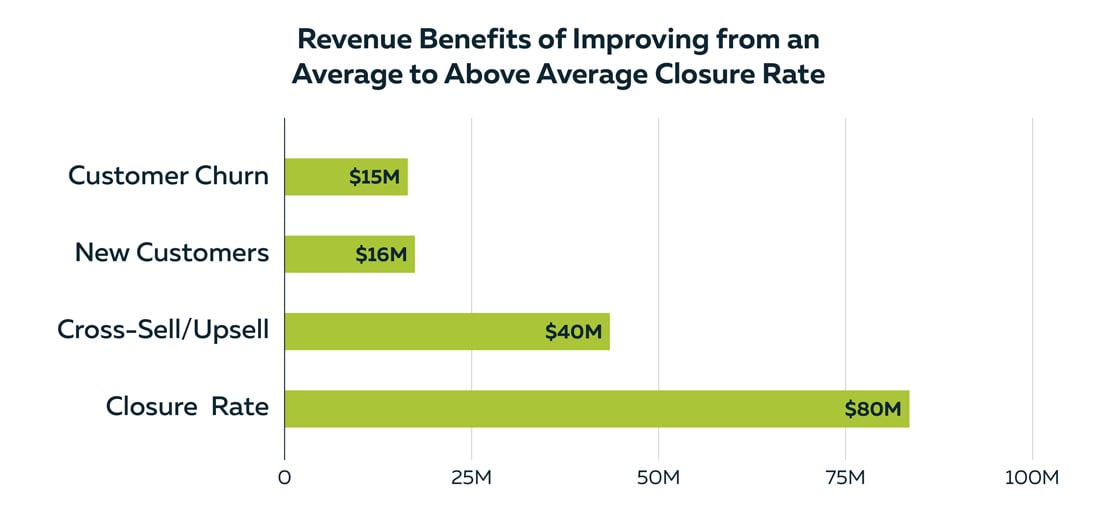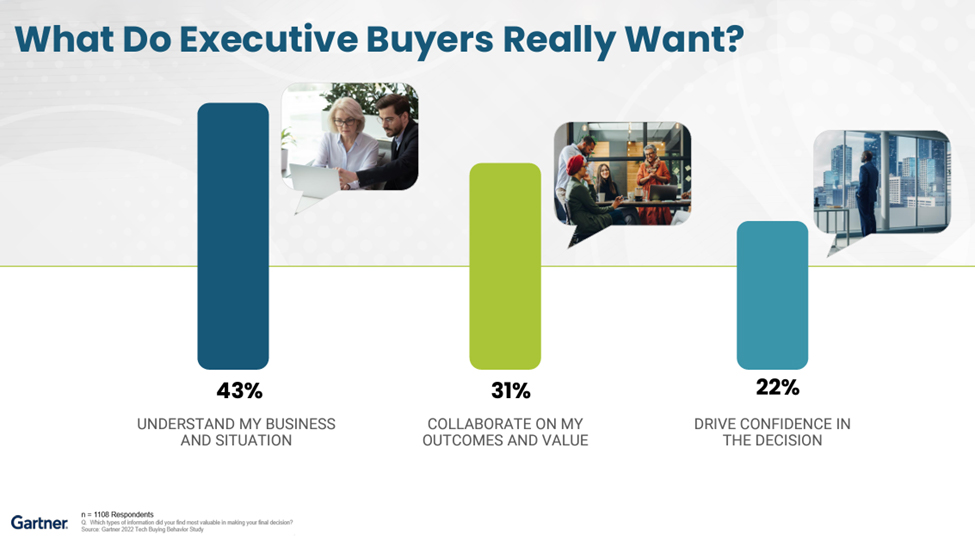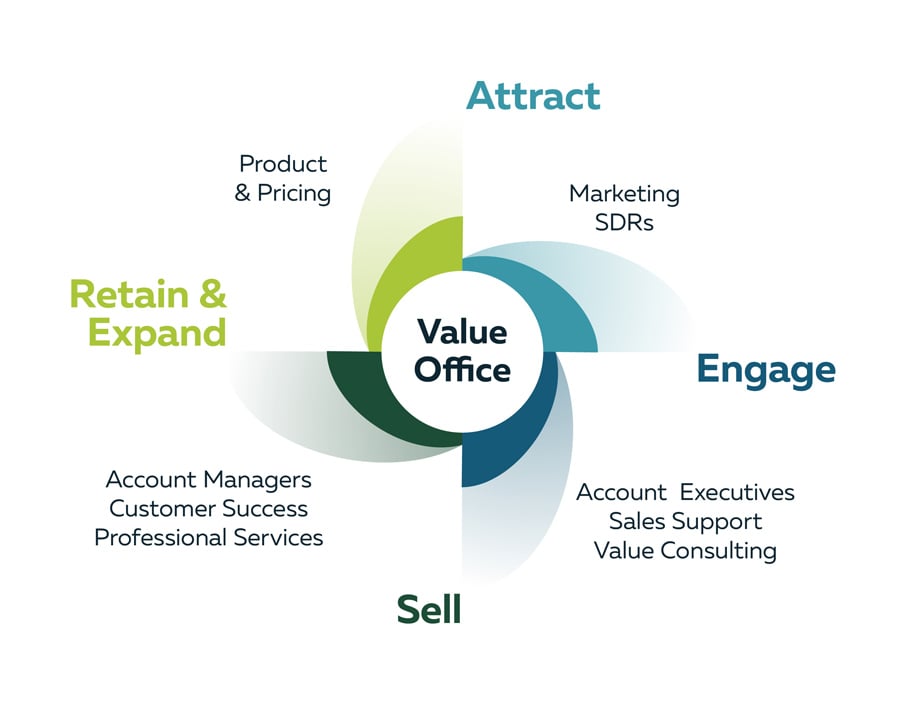As enterprise B2B buyers' needs continue to evolve and their spending increasingly turns more frugal, now is the time for sales leaders to seek out new approaches to engage more effectively with clients. FinListics recently held a webinar with our friends at Genius Drive on new approaches to value-focused selling and customer journeys.
Unlocking The Four Cornerstones of Value in Enterprise B2B
Before we dive further into value-focused selling, let us briefly cover the elements of value. Primarily, there are four critical elements in delivering value for enterprise B2B companies:
- Growing revenue
- Saving and / or avoiding costs
- Boosting productivity and streamlining processes
- Reducing and mitigating enterprise risk
In addition, another important value element is creating personal value for executives and members of the buying team by helping them gain recognition, career advancement, and achieve performance objectives.
Quantitative Benefits of a Value-Based Selling Approach

Adopting a value-based selling approach can significantly boost revenue. According to FinListics research, companies with $1 billion in revenue that improved their closure rate from median to first quartile gained an average of $80 million in sales.
Additionally, Genius Drive’s analysis of their customers showed that this approach drives an improved win rate of 15 - 30 percentage points. Their studies also uncovered improved acceleration of the sales cycle and increases in deal sizes.
Understanding the Source of Buyer’s Value Gap
Recent Gartner research on buyer sentiment analyzed the amount of regret that occurs in B2B technology-related purchases. Gartner found a startling level of regret from surveyed enterprise IT buyers:
- 73% - Bought but did not implement solution and indicated high-regret
- 56% - Total purchases that were deemed high-regret
- 13% - Purchases categorized as no-regret
This buyer’s value gap should be very concerning for enterprise B2B sales leaders. Purchase regret leads to customers downgrading and less likelihood of adding to the initial sale. For selling groups, this leads to reduced sales, frustrated sales personnel, and longer buying cycles.
In many enterprise B2B pursuits, a significant source of misalignment is due to the buyer’s technology evaluation group not being the ultimate buyer. As a result, the discussion begins and focuses primarily on features and functions. Then the senior leaders who are the ultimate buyers bring a value, not a technology perspective, to their decision, resulting in a value gap.
Secondly, the typical B2B sales pursuit team - sales personnel, customer success team members, and sales engineers - started their careers in technology roles. So, the sales organization has an elevated level of expertise to talk about the solutions’ technology. But when discussing value, they often lack the necessary nomenclature and overall understanding.
Lastly, many selling organizations still rely on pitching features and functions to prospects. But clients are not buying the “product”; they are purchasing a resolution to pain points or addressing a business priority.
Closing the Buyer’s Value Gap
To start, what characterizes a customer-centric, value-focused sales group? It is a sales culture where every activity starts with and revolves around the customer. Specifically, it means:
- Ensuring customers will receive value from the proposed solution
- Verifying that customers are receiving the promised value from the purchased solution
- Leveraging the client’s value achieved to grow a long-term relationship
A recent survey by Gartner of B2B executive buyers that had low-regret technology purchases found three critical factors in what they were seeking from sellers.

- 43% - Understand My Business and Situation - Customers expect your sales team to bring fresh insights and not just talk about your solution.
- 31% - Collaborate on My Outcomes and Value - Similar in nature, was the response that buyers did not want sellers to focus on features but to collaborate on the outcomes and the expected value achieved from deploying the solution.
- 22% - Drive Confidence in the Decision - The tightened economy, risk of making the wrong choice, and increase in stakeholders involved have inserted additional doubt among buying organizations. Buyers seek engagements with sellers that reinforce their confidence in the solution and expected outcomes.
As discussed earlier, one challenge that value-based selling faces is customers focused on product features. To manage this situation, your team must be fluent in the language of executives. In addition to improving discussions with senior leadership, it also quickly changes the path of conversations with tech-focused buying team members. They will soon recognize they are not the right group for the discussion.
Next, your team needs to learn not just the terminology of executives, but how to talk about it in depth, to hold engaging and impactful discussions. It is critical to elevate conversations to the highest levels of the client organization.
Lastly, consider introducing a Chief Value Officer (CVO) role or establishing a "Value Office" to help institutionalize value-selling in your organization.
Time for a New C-level Executive - Chief Value Officer

The concept of a CVO or Value Office is starting to gain traction. By elevating the role to a C-suite position, your value-based sales approach gains more influence, funds, and access to the strategic agenda. Following the Genius Drive value lifecycle and the elevation of a CVO or formation of a Value Office are needed to drive higher win rates and more enduring client relationships.
Genius Drive’s research found that companies that displayed the following traits were best equipped to deliver optimum results with a value-based approach:
- Close orchestration within the organization to cover all customer touchpoints. To start, there needs to be coordination with Marketing and Sales Development to ensure consistency of the message conveyed to the market and prospects. This messaging then must be cascaded in subsequent discussions with customers by sales personnel and the executive team. It should also be applied throughout the rest of the customer’s journey to account executives, sales support, value consulting, and other functions.
- Quantify the value of the client’s change, identification of the specific problems the solution helped overcome, and the realized value of the solution delivered.
- Often overlooked is the alignment of the Product Management team to focus their efforts on the outcomes and value delivered to clients. Instead of prioritizing the latest technology feature that is showy but delivers little real value to customers.
- Ensuring that solution pricing is based on the value being delivered and not randomly based on market or competitive pricing.
Alternatively, if your organization is not ready for the big leap to a CVO or Value Office and wants to make an interim step forward, you can have the above value-related functions report to the Chief Revenue or Customer Officer. These actions will move your value-centric selling initiative forward and closer to the span of influence required for success.
Elevate your Sales Strategy with FinListics: A Transformative Approach
To learn more about how you can elevate your sales team to a value-based selling approach, please watch our recent webinar, “Crafting Superior Customer Journeys With a Chief Value Officer”. Our President and Founder, Dr. Stephen Timme, was joined by Tom Pisello and April Morley of Genius Drive. Connect with them through the Enterprise Value Collective. Learn more on the EVC LinkedIn Page and the EVC LinkedIn Group.
Due to the changing needs of B2B enterprise buyers and a sluggish economy, now more than ever requires a transformative shift in your group’s selling approach. FinListics offers a range of tools to help enterprise B2B sales teams successfully embrace value-based selling.
To talk with one of our experts on how you can start your journey to value-based selling, please contact us today.
